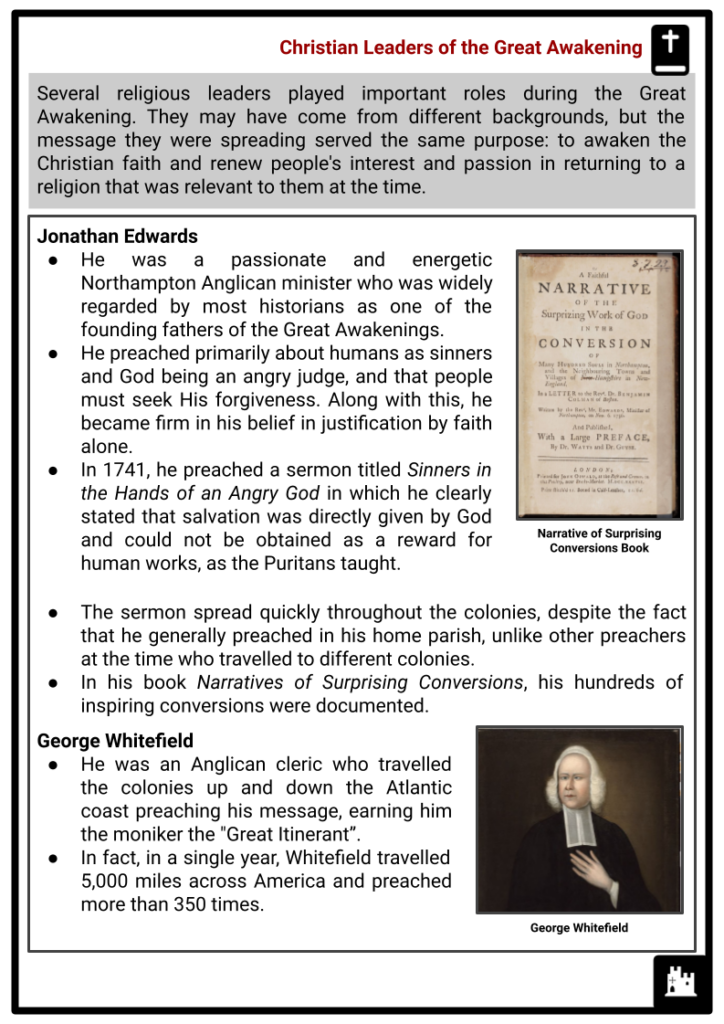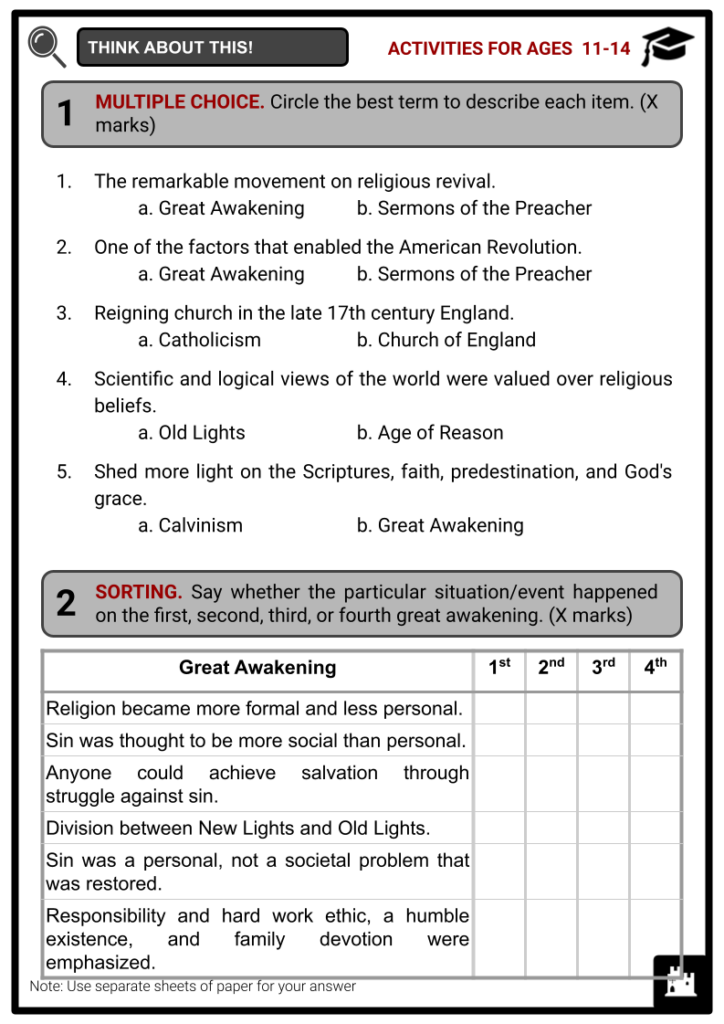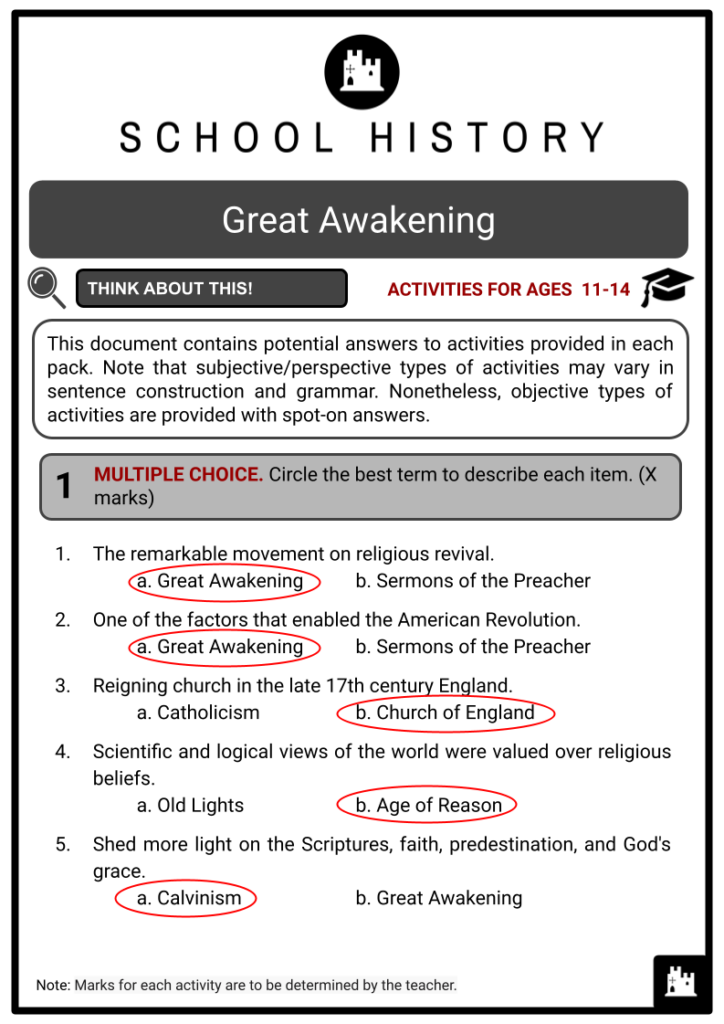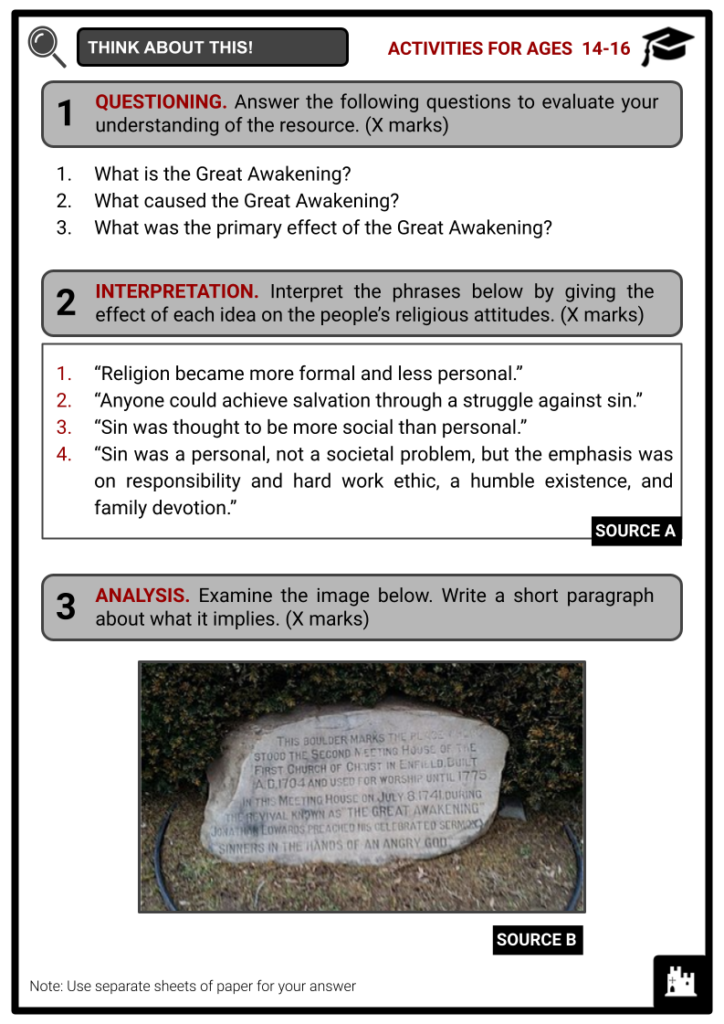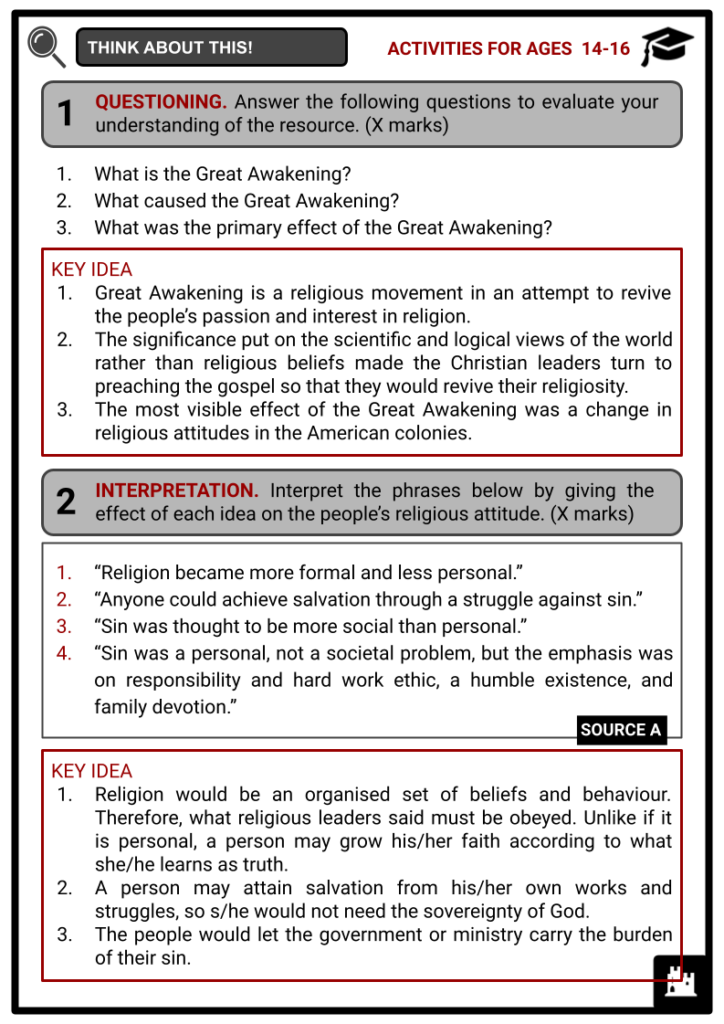Great Awakening Worksheets
Do you want to save dozens of hours in time? Get your evenings and weekends back? Be able to teach about the Great Awakening to your students?
Our worksheet bundle includes a fact file and printable worksheets and student activities. Perfect for both the classroom and homeschooling!
Summary
- Christian Leaders of the Great Awakening
- Origin and Cause of the Great Awakening
- Four Phases of Religious Revival
- First, Second, Third & Fourth Great Awakening
- Effects of the Great Awakening
Key Facts And Information
Let’s find out more about the Great Awakening!
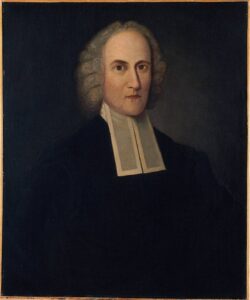
The remarkable movement of religious revival that had a significant impact on the English colonies in America during the 1730s and 1740s is most commonly known as the Great Awakening. It occurred at a time when secular reasoning was emphasised while religion was declining. Christian leaders travelled from town to town, spreading the gospel while shedding more light on salvation from sins and trying to promote a passion for Christianity. It resulted in a renewed interest in religion. Many historians agree that the Great Awakening's impact on various Christian denominations and American culture was far from simple.
Christian Leaders of the Great Awakening
- Several religious leaders played important roles during the Great Awakening. They may have come from different backgrounds, but the message they were spreading served the same purpose: to awaken the Christian faith and renew people's interest and passion in returning to a religion that was relevant to them at the time.
Jonathan Edwards
- He was a passionate and energetic Northampton Anglican minister who was widely regarded by most historians as one of the founding fathers of the Great Awakenings.
- He preached primarily about humans as sinners and God being an angry judge, and that people must seek His forgiveness. Along with this, he became firm in his belief in justification by faith alone.
- In 1741, he preached a sermon titled Sinners in the Hands of an Angry God in which he clearly stated that salvation was directly given by God and could not be obtained as a reward for human works, as the Puritans taught.
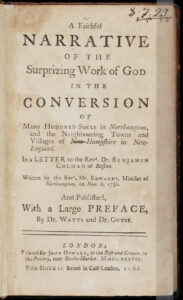
Narrative of Surprising Conversions Book - The sermon spread quickly throughout the colonies, despite the fact that he generally preached in his home parish, unlike other preachers at the time who travelled to different colonies.
- In his book Narratives of Surprising Conversions, his hundreds of inspiring conversions were documented.
George Whitefield
- He was an Anglican cleric who travelled the colonies up and down the Atlantic coast preaching his message, earning him the moniker the "Great Itinerant”.
- In fact, in a single year, Whitefield travelled 5,000 miles across America and preached more than 350 times.
- Thousands of people came to hear Whitefield because of his expressive and theatrical style. He, even trembled during his sermons when shouting the word of God. He also became friends with Benjamin Franklin after his sermons captivated the religious sceptic.
- No one should be denied the opportunity to hear the gospel, according to him. He preached to a wide range of people, from commoners to slaves and Native Americans.
- He was successful in convincing English colonists to join local churches.
Gilbert Tennent
- He was a pietistic Protestant Evangelist in colonial America who helped lead the Great Awakening.
- The most popular of his sermons was The Danger of an Unconverted Ministry.
New Lights and Old Lights
-
- The ideas of the Great Awakening were not universally accepted. Charles Chauncy, a minister in Boston, was one of the prominent opponents. He was a critic of Whitefield's preaching, while he preferred the traditional, formal style of religion.
- A debate about the Great Awakening occurred around 1742, and the decision was made to divide the New England clergy and colonists into two groups.
- The new lights were those who adopted new ideas, while the old lights were those who stuck with the traditional church.
Origin and Cause of the Great Awakening
- The establishment of the Church of England as the country's reigning church in the late 17th century put an end to the conflict between religious and political groups. Meanwhile, religions such as Catholicism, Judaism, and Puritanism were outlawed.
- When Puritan Oliver Cromwell died in 1658, Anglican Charles II acceded to the throne and was welcomed by the general public. Charles was so determined to rid his court of Puritan influences that he dug up Cromwell's body for all to see.
- Puritans, who had previously grown in number, were now being held back from the renewed monarchical England's options of power. Catholics, on the other hand, despite constituting a small minority in the country, were supported by some powerful allies.
- Catholics' concerns were taken into account by King Charles, and he and Louis XIV agreed to join the French in opposing Holland and to restore Roman Catholicism to England in the Treaty of Dover in 1670.
- Politically, one could argue that the government was now more stable because of religious uniformity. However, the opposite occurred because it only created the government's self-satisfaction while the believers experienced meaningless in their faith. During that time, religion was reduced to a mere pastime for most people.
- The government's self-satisfaction led to the suppression of minority religious groups such as Jews, Catholics, and Unitarians through strict penalties.
- Colonists returning to England shared their motherland's fear of Catholic and Stuart control, and they were pleased with the spread of Whig ideals to the New World. The colonists' vision was quickly disproved, as strict unified rule over the colonies continued under most of the same regulations that constrained the land before the revolution.
- The Great Awakening became a movement to reawaken people's spiritual inclinations. It arose when the role of the individual in religion and society was questioned by European and American colonies when people began to rely more on a personal approach to salvation rather than church dogma and doctrine.
First Great Awakening
- During the 1700s, a European philosophical movement known as the Enlightenment was making its way from the Atlantic to the American colonies. Its members valued scientific and logical views of the world over religious beliefs, earning it the title "Age of Reason”.
- Religion became more formal and less personal during this period, which decreased people's interest and passion for the church.
- Christians were satisfied with their way of worship while some were concerned with the idea of wealth and rationalism as the dominant culture.
- Many dissatisfied people yearned for a revival of religious zeal.
- Religious differences divided the 13 colonies, and the majority of New England adhered to congregational churches.
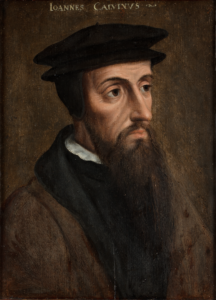
Jean Cauvin / John Calvin - The Middle colonies comprised Anglicans, Baptists, Congregational followers, Dutch Reformed, Lutherans, Presbyterians, and Quakers.
- Those colonies in the South mostly became Anglicans, though a small number became Baptists, Presbyterians, or Quakers.
- A renewal of faith was awaiting. The revival began in the late 1720s when preachers revised their messages to emphasise Calvinist concepts.
- The First Great Awakening ended with the introduction of revival meetings that emphasised spiritual rebirth and the emergence of kindness toward different ethnicities.
- The conflict and division left by the First Great Awakening were primarily on the New Lights and Old Lights, with the latter opposing the former on emotional or irrational aspects of the Awakening.
Read more!
Calvinism was the name given to the theology introduced by John Calvin in the 16th century and named after him. It shed more light on the scriptures, faith, predestination, and God's grace.
Second, Third & Fourth Great Awakenings
- While some historians believe the Great Awakening ended on the Second one, others believe it lasted four phases. The significance of the events after the Second Great Awakening became debatable.
Second Great Awakening
- Around the 1740s, the First Great Awakening came to an end. Approximately five decades later, another religious revival began in New England, and became known as the Second Great Awakening.
- The Second, in contrast to the First, was thought to be less emotionally charged. It inspired the establishment of numerous colleges, seminaries, and mission societies.
- The belief that anyone could achieve salvation through struggle against sin rose during the Second Great Awakening. The intensity of revivals increased as well.
Third Great Awakening
- A Third Great Awakening was predicted between the late 1850s and the early 2000s. However, some scholars argue that this movement was never a significant event.
- It was thought sin to be more social than personal during the Third Great Awakening. As a result, it was widely considered that poverty was a social problem that could be handled by the state rather than a personal one.
Fourth Great Awakening
- Finally, there was the Fourth Great Awakening, whose significance was questioned more than the Third.
- An economist and advocate named Robert Fogel said that the fourth one began in the 1960s.
- Fundamentalist, Pentecostal, and Protestant charismatic faiths, as well as "Born-Again" Catholics and Mormons, all existed as enthusiastic religions.
- The idea that sin was a personal, not a societal problem was restored, but the emphasis was on responsibility and hard work ethic, a humble existence, and family devotion.
Effects of the Great Awakening
- The most visible manifestation of the Great Awakening was a change in religious attitudes in the American colonies. It taught people to have a personal relationship with God rather than relying on a minister. Newly formed denominations like the Methodists and Baptists grew quickly. The number of followers grew in tandem with the number of churches, but it caused divisions in different churches.
- The Great Awakening was said to have influenced the Revolutionary War because, according to many historians, it inspired people to practise nationalism alongside their individual rights.
- More specifically, the movement elevated individuals and their spiritual experiences above church doctrine.
- As a result of the religious revival, not only churches but educational institutions were established. This included Brown, Dartmouth, Princeton, and Rutgers.
- The Awakening also made the colonists realise that religious power did not belong to the Church of England or any other religious authority, but to them. It was later applied to political issues because the colonists believed that political power lay in their hands rather than the English monarch's.
- Even though their theological beliefs differed, by 1775, the colonists shared a common vision of freedom from British control. As a result, the Great Awakening was one of the factors that enabled the American Revolution.
Image Sources
- https://upload.wikimedia.org/wikipedia/commons/thumb/4/4b/Jonathan_Edwards_%28Princeton_Portrait%29.jpg/800px-Jonathan_Edwards_%28Princeton_Portrait%29.jpg
- https://upload.wikimedia.org/wikipedia/commons/thumb/9/9e/A_Faithful_Narrative_of_the_Surprizing_Work_of_God_by_Jonathan_Edwards_1737.jpg/800px-A_Faithful_Narrative_of_the_Surprizing_Work_of_God_by_Jonathan_Edwards_1737.jpg
- https://upload.wikimedia.org/wikipedia/commons/thumb/5/58/John_Calvin_Museum_Catharijneconvent_RMCC_s84_cropped.png/800px-John_Calvin_Museum_Catharijneconvent_RMCC_s84_cropped.png


